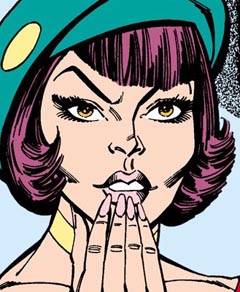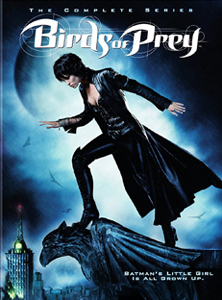On somewhat of a “Batman” kick while enjoying the latest strong season of “Gotham,” I decided to explore some other corners of the Bat-verse. While “The Killing Joke” or the Nolan films or “Batman: The Animated Series” might’ve been wise choices, I’m apparently a glutton for punishment, because I selected “Birds of Prey” (2002-03, WB; now streaming on CW Seed) as my window into past lore.
While the 13-episode series is fodder for plenty of talking points and trivia – for example, it’s the only live action Bat-verse TV series other than the 1960s “Batman” and “Gotham” – it’s not particularly enjoyable to watch.
A sturdy setup
The setup is sturdy enough. Thirty-something Barbara Gordon/Batgirl (Dina Meyer), now confined to a wheelchair and known as Oracle, 20-something Helena Kyle/Huntress (Ashley Scott, coming off “Dark Angel”), and teen Dinah (Rachel Skarsten) are the titular crime fighters. The title comes from the comic of the same name, although I’m not sure where the term comes from.

“Birds of Prey” (2003-04)
WB, 13 episodes
Creator: Laeta Kalogridis
Stars: Ashley Scott, Dina Meyer, Rachel Skarsten
A bat isn’t a bird, nor is a huntress. Dinah’s mom is Black Canary (“Summerland’s” Lori Loughlin), but while Dinah may have eventually inherited her mom’s moniker, as some unimaginative superheroes do, it doesn’t happen in these 13 episodes. Maybe the title refers to “bird” in the 1960s colloquial sense. In that sense, “Birds of Prey” casts a nice variety, with the pretty one, the hot one and the cute one.
The actresses are decent, as Meyer makes Oracle’s computer mumbo-jumbo not sound silly, and Skarsten supplies spunky energy. Trying to be brooding, Scott is instead a bit bland, but at least she’s easy on the eyes.
The biggest problem with “Birds of Prey” is the slow-moving and redundant scripts. Several times, Huntress tells cop/love interest Jesse (Shemar Moore) that she “works alone,” usually on dark, empty streets. Several times, Dinah is rebuffed in her requests to join a mission. Several times, Barbara broods about not being worthy of a real relationship because her legs don’t work. (By the way – huh? She has everything else going for her – she’s gorgeous, brilliant, endlessly wealthy and a superhero. AND she’s working on a device that will allow her to walk.)
Telegraphed plots
Even when it’s not spelling things out in the dialog, the plots are telegraphed. Early in “Reunion,” Huntress says she has figured out who the bad guy is based on one obvious clue – he’s clutzy, and shapeshifters are known to be clutzy. On a better show – say Season 1 of “Buffy” – that suspect would be a red herring and the actual baddie would be revealed later. On this show, it’s just a series of increasingly more successful “good guy vs. bad guy” encounters until the 45 minutes are up.

Speaking of “Buffy,” Christopher Wiehl plays a nice guy named Jack who pines after Huntress in “Reunion,” and he’s EXACTLY the same character as Owen from “Never Kill a Boy on the First Date.” The director might’ve said, “Just play Owen again.” On the topic of ripoffs, “Gladiatrix” – where a mind-drugged Huntress and Dinah end up facing off in an underground cage match – has the same plot as “Angel’s” “The Ring.”
Like “Gotham,” “Birds of Prey” creates establishing shots of Gotham with CGI buildings and skyscapes, but it does so in an obviously CGI way (it gets less bad toward the later eps). Scenes tend to play out slower than they should, as if the directors are going for mood. Yet the plots are too shallow to work as anything other than fast-paced camp, and the dialog lacks zest. Faster pacing might’ve pushed “Birds of Prey” toward “Supergirl” territory, but it languishes just a notch above “Power Rangers” in quality.
To cite one example of sloppiness from the story editors, in “Prey for the Hunter,” Barbara makes reference to a bad (off-screen) experience meeting the parents of her boyfriend Wade (Shawn Christian, in another “Summerland” connection), who intimate that she’s not good enough for their son because she’s in a wheelchair.
The show then repurposes that date scene for a later episode, forgetting that Barbara made the comment. So she has two bad “first” meetings with Wade’s folks. To cite another example, Dinah is initially the uncool new kid at school, then later she’s popular and has friends; there is no transitional episode, or even a single scene.
Slow-moving overall plot
The series’ overall plot is slooooow moving. Barbara and Helena don’t let Dinah fully participate in missions until episode 10 – despite the fact that Dinah (a metahuman, as is Huntress) has innate telekinetic and mind-reading powers.
Gibson (Rob Benedict), a bartender at a metahuman bar, could’ve been a great addition to the team with his flawless recall (he even remembers being born), but the writers only go there in one episode. Alfred (Ian Abercrombie of “Seinfeld” and “Star Wars: The Clone Wars”) could’ve provided wisdom or dry comedy, but the writers are content to have him be a butler most of the time.
The Big Bad – and, yes, Barbara uses the term “Big Bad,” because that’s how blunt “Birds of Prey” is, and how badly it wants to be as cool as “Buffy” – is Dr. Harleen Quinzel, aka Harley Quinn (Mia Sara). But she doesn’t realize her patient, Helena, is Huntress until the final episode, “Devil’s Eyes.” At that point, she finally takes over the Clocktower headquarters in a villainous push.
While she does some wicked things like kill lackeys without a care, it doesn’t make sense that Harley Quinn would hatch such a slow-boil scheme, unless perhaps the Joker was keeping her on a leash. Additionally, Sara – in the first live-action portrayal of Quinn — plays her with a calm menace, rather than with the manic cruelty the character became famous for in “Batman: The Animated Series.”
The fight scenes are not great, but not embarrassing, although I don’t know of another show where all the windows are made of breakaway safety glass. If there’s a pane of glass in a shot, it’s a safe bet someone will fly through it. Mark Snow, fresh off the end of “The X-Files,” provides some gothic tones in the score, although I assume he didn’t provide the generic video-game style music that kicks in during the fight scenes.
Morphing effects are good
In the interest of finding something to praise: The morphing effects are quite good. In “Three Birds and a Baby,” a baby grows to an old man in a matter of days, and all the morphing effects are believable. Same thing when Kristoffer Polaha’s Darkstrike morphs into Brian Thompson’s Crawler in “Split.”
So that’s my review of the quality – it’s not great. But as a Bat-verse show, it also offers up some talking points. The first question people might have is: What Bat-saga is this a sequel to? The answer, oddly, is none of them. Tonally, it’s closest to the Schumacher films, whose story continued from the Burton films. And Huntress is half-metahuman, being the daughter of Batman and Catwoman, who is a metahuman in “Batman Returns” (she’s just-plain human in most “Batman” sagas).
But the story points don’t line up: Most notably, the Joker is alive and at large in “Birds of Prey”; no doubt, he would’ve appeared had the series gone on longer. (Interesting tidbit: Mark Hamill of “The Animated Series” voices Joker in his introductory-flashback appearance.) Batman, who disappeared seven years ago, is little more than a rumor in this world; he apparently didn’t do his crimefighting as brazenly as in the 1990s movies. And Catwoman, of course, doesn’t have a kid in the movies.
Most weirdly of all, “Birds of Prey” takes place in “New Gotham City,” and there’s no explanation for why the city bears this name. One might think Gotham City was destroyed – perhaps in the battle between Batman and Joker referenced in the opening – and New Gotham was built from the ashes. But nope, Batman himself patrolled New Gotham back in the day, we’re told.
Some ‘Batman’ connections
“Gladiatrix” tells us the fighting ring is in “Old Gotham,” but that doesn’t clear things up. I almost wonder if the producers – one of whom is Laeta Kalogridis, later known for writing “Terminator Genisys” — decided to call it New Gotham simply to make it clear that “Birds of Prey” is not linked to any other Batman franchise; like a pre-emptive apology.
Other than Harley Quinn, the most notable “Batman” rogue to appear in “Birds of Prey” is Clayface, in the penultimate and best episode, “Feat of Clay.” Kirk Baltz has an interesting inflection in his voice, and the makeup is good, even though Clayface’s motivations are the same as all “Birds of Prey” villains – to do a spot of evil and get away with it.
Some villains – like Darkstrike/Crawler – seem like comic baddies, but they aren’t actually. Others, like Shiva (Sung Hi Lee), do indeed come from the “Birds of Prey” comics. But generally, this TV series is only loosely based on the comic (1995-present), which starred the duo of Oracle and Black Canary (rather than Canary’s daughter), and later the duo of Oracle and Huntress. It also has Catwoman as a contemporary figure, rather than as the deceased mother of Huntress.
So all told, the “Birds of Prey” TV series is a dull entry in “Batman” lore, but because it’s so disconnected from other interpretations, it has the saving grace of being easy to dismiss. As a “Gotham” fan, you might be curious about this series, but trust me – when delving into the lore, “Birds of Prey” should be toward the bottom of your list.

